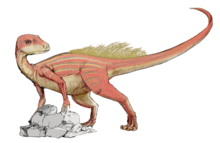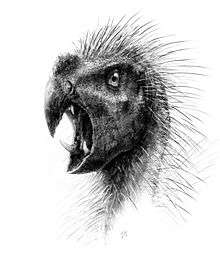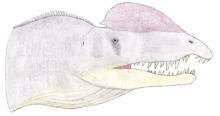Elliot Formation
| Elliot Formation Stratigraphic range: Norian-Sinemurian ~210–190 Ma | |
|---|---|
| Type | Geological formation |
| Unit of | Stormberg Group |
| Sub-units | Upper & Lower Elliot Formations |
| Underlies | Clarens Formation |
| Overlies | Molteno Formation |
| Lithology | |
| Primary | Limestone, sandstone, mudstone |
| Location | |
| Coordinates | 30°30′S 27°24′E / 30.5°S 27.4°ECoordinates: 30°30′S 27°24′E / 30.5°S 27.4°E |
| Approximate paleocoordinates | 44°06′S 1°54′W / 44.1°S 1.9°W |
| Region | Eastern Cape, Orange Free State, Mafeteng, Maseru, Quthing, Qacha's Nek & Mohale's Hoek |
| Country |
|
The Elliot Formation is a geological formation dating to roughly 210 to 190 million years ago and covering the Norian to Sinemurian stages. The Elliot Formation is found in South Africa and Lesotho and is a member of the Stormberg Group. It consists mainly of limestone, sandstone, and mudstone. Fossils of the prosauropod dinosaur Massospondylus have been recovered from the Upper Elliot Formation.
Stratigraphy
| Stratigraphy of the Karoo Supergroup in the Karoo Basin | ||||
|---|---|---|---|---|
| Period | Group | Formation west of 24°E | Formation east of 24°E | Assemblage Zone |
| Jurassic | Drakensberg | Hiatus | Drakensberg | |
| Stormberg | Clarens | |||
| Triassic | Elliot | |||
| Molteno | ||||
| Beaufort | ||||
| Burgersdorp | Cynognathus | |||
| Katberg | Lystrosaurus | |||
| Balfour | ||||
| Permian | Dicynodon | |||
| Teekloof | ||||
| Cistecephalus | ||||
| Middleton | ||||
| Tropidostoma | ||||
| Pristerognathus | ||||
| Abrahams-Kraal | Koonap | |||
| Tapinocephalus | ||||
| Eodicynodon | ||||
| Ecca | Waterford | Waterford | ||
| Tierberg / Fort Brown | Fort Brown | |||
| Laingsburg / Ripon | Ripon | |||
| Collingham | Collingham | |||
| Whitehill | Whitehill | |||
| Prince Albert | Prince Albert | |||
| Carboniferous | Dwyka | Elandsvlei | Elandsvlei | |
| References: Rubidge (2005),[1] Selden and Nudds (2011).[2] | ||||
Vertebrate fauna
Dinosaurs
Unidentified dinosaur eggs have been recovered from the formation.[3]
Ornithischia
An unnamed ornithischian genus has been reported from the Upper Elliot Formation.[3] Geographically it was located in the Mafeteng district, Lesotho.[3] Ornithischian tracks have been reported from the Upper Elliot Formation.[3] Geographically they were located in Leribe District,[4] Mafeteng district, and Mohales Hoek District, Lesotho.[3] Possible indeterminate ornithischian remains have been reported from the Lower and Upper Elliot Formation of Cape Province, South Africa[4] and the Mohales Hoek District, Lesotho.[3]
Color key
|
Notes Uncertain or tentative taxa are in small text; |
| Ornithischian dinosaurs of the Elliot Formation | ||||||
|---|---|---|---|---|---|---|
| Genus | Species | Location | Stratigraphic position | Material | Notes | Images |
|
A. consors[3] |
|
"[Two] skulls, [one] associated with fragmentary skeleton; material consisting of either male and female or adult and juvenile."[5] |
The Qacha's Nek District remains were once considered Lycorhinus consors.[3] |
| ||
|
F. australis[3] |
|
"Fragmentary dentary with teeth."[6] |
Its remains are now considered indeterminate ornithischian.[3] | |||
|
H. tucki[3] |
|
|||||
|
Indeterminate[3] |
|
|||||
|
L. scalpridens |
|
Now regarded as a junior synonym of Lycorhinus. | ||||
|
L. diagnosticus[4] |
|
"At least [four] skulls and associated skeletal material."[6] |
||||
|
L. angustidens[3] |
|
"Isolated dentary maxillae."[5] |
||||
|
L. consors[3] |
|
Split off as the type species of the new genus Abrictosaurus. | ||||
|
P. africana[7] |
|
|
||||
Sauropodomorpha
Prosauropod tracks have been found in the Lower and Upper Elliot Formation.[4][3] Geographically, these finds have been located in Leribe District, Mafeteng District, Mohales Hoek district, Quthing District,[3] and Maseru District, Lesotho.[4] Possible prosauropod tracks have been located in the Lower Elliot Formation. Geographically these were located in Cape Province, South Africa.[4]
Color key
|
Notes Uncertain or tentative taxa are in small text; |
| Sauropodomorph dinosaurs of the Elliot Formation | ||||||
|---|---|---|---|---|---|---|
| Genus | Species | Location | Stratigraphic position | Material | Notes | Images |
|
A. celestae |
|
| ||||
|
A. palustris |
|
"Cervicals, caudals, partial fore- and hindlimb."[8] |
Elliot material formerly referred to this taxon was later concluded to be indeterminate prosauropod remains.[3] | |||
|
A. ingenipes[4] |
|
|||||
|
B. cromptoni[4] |
|
"Associated left tibia, fibula, tarsus, [and] pes."[10] |
||||
|
D. gracilis |
|
Elliot material formerly referred to this taxon was later concluded to be indeterminate prosauropod remains.[3] | ||||
|
E. fortis |
|
"Fragmentary skeleton."[8] |
||||
|
E. africanus |
|
"Vertebrae, ischia, incomplete ilia, tibiae and femora."[8] |
Elliot material formerly referred to this taxon was later concluded to be indeterminate prosauropod remains.[4] | |||
|
E. browni[4] |
|
|||||
|
Indeterminate[4] |
|
|||||
|
G. africanus |
|
"Vertebrae, both manus, pelvis and hindlimbs."[8] |
A valid sauropodomorph genus and species.[11] | |||
|
G. taylori |
|
"Sacrals, pelvic girdle."[8] |
Elliot material formerly referred to this taxon was later concluded to be indeterminate prosauropod remains.[3] | |||
|
H. skirtopodus |
|
Elliot material formerly referred to this taxon was later concluded to be indeterminate prosauropod remains.[3] | ||||
|
I. rachelis[12] |
|
|||||
|
L. mafube |
|
"associated postcranial material" |
A giant lessemsaurid sauropod |
|||
|
L. capensis |
|
"Caudals."[8] |
Elliot material formerly referred to this taxon was later concluded to be indeterminate prosauropod remains.[3] | |||
|
M. browni |
|
"Cervicals, dorsal, caudals, pedal elements."[8] |
Elliot material formerly referred to this taxon was later concluded to be indeterminate prosauropod remains.[3] | |||
|
M. carinatus[3] |
|
|||||
|
M. harriesi |
|
"Forelimb."[8] |
Elliot material formerly referred to this taxon was later concluded to be indeterminate prosauropod remains.[3] | |||
|
M. schwarzi |
|
Elliot material formerly referred to this taxon was later concluded to be indeterminate prosauropod remains.[3] | ||||
|
Indeterminate[3] |
||||||
|
M. readi[4] |
|
"[Three] partial skeletons, adult."[14] |
||||
|
Indeterminate[4] |
|
|||||
|
M. thabanensis[9] |
|
"Femur, adult."[14] |
||||
|
O. capensis |
|
"Proximal tibia."[8] |
Elliot material formerly referred to this taxon was later concluded to be indeterminate prosauropod remains.[4] | |||
|
P. orpenii |
|
"Fragmentary vertebrae."[8] |
Elliot material formerly referred to this taxon was later concluded to be indeterminate prosauropod remains.[3] | |||
|
"Partial skeleton."[8] |
|||||
|
P. stormbergensis |
|
Elliot material formerly referred to this taxon was later concluded to be indeterminate prosauropod remains.[4] | ||||
|
T. browni |
|
Elliot material formerly referred to this taxon was later concluded to be indeterminate prosauropod remains.[3] | ||||
|
T. minor |
|
Elliot material formerly referred to this taxon was later concluded to be indeterminate prosauropod remains.[3] | ||||
Theropoda
Theropod tracks are stratigraphically located in both the Lower and Upper Elliot Formation. Geographically, they are located in the Leribe District, Mafeteng District, Quthing District,[3] Maseru District and Mohales Hoek district,[4][3] Lesotho.[4]
Color key
|
Notes Uncertain or tentative taxa are in small text; |
| Theropod dinosaurs of the Elliot Formation | ||||||
|---|---|---|---|---|---|---|
| Genus | Species | Location | Stratigraphic position | Material | Notes | Images |
|
A. rex[4] |
|
Partial femur and possible maxilla.[17] |
Now known to be a chimera of Eucnemesaurus and a theropod mandible. |
| ||
|
D. regenti[18] |
|
|||||
|
Former Megapnosaurus rhodesiensis. | |||||
|
M. rhodesiensis[3] |
|
|||||
|
S. rhodesiensis[3] |
|
|||||
Cynodonts
| Cynodonts of the Elliot Formation | ||||||
|---|---|---|---|---|---|---|
| Genus | Species | Location | Stratigraphic position | Material | Notes | Images |
|
M. rudnerae[19] |
|
Upper Elliot Formation[19] |
Skull and isolated vertebrae[19] |
|||
See also
References
- ↑ Rubidge, B.S. (2005). "Re-uniting lost continents – Fossil reptiles from the ancient Karoo and their wanderlust". South African Journal of Geology. 108 (1): 135–172. doi:10.2113/108.1.135.
- ↑ Selden, P.; and Nudds, J. (2011). "Karoo". Evolution of Fossil Ecosystems (2 ed.). Manson Publishing. pp. 104–122. ISBN 9781840761603.
- 1 2 3 4 5 6 7 8 9 10 11 12 13 14 15 16 17 18 19 20 21 22 23 24 25 26 27 28 29 30 31 32 33 34 35 36 37 38 39 40 41 42 43 44 45 46 47 48 49 50 51 52 53 54 55 56 57 58 59 60 61 62 63 64 65 66 67 68 69 70 71 72 73 74 75 76 77 78 79 80 81 82 83 84 85 86 87 88 89 90 91 92 93 94 95 96 97 98 99 100 101 Weishampel, David B; et al. (2004). "Dinosaur distribution (Early Jurassic, Africa)." In: Weishampel, David B.; Dodson, Peter; and Osmólska, Halszka (eds.): The Dinosauria, 2nd, Berkeley: University of California Press. Pp. 535–536. ISBN 0-520-24209-2.
- 1 2 3 4 5 6 7 8 9 10 11 12 13 14 15 16 17 18 19 20 21 22 23 24 25 26 27 28 29 30 31 32 33 34 35 36 37 38 39 40 41 42 43 44 45 46 47 48 49 50 51 52 53 54 Weishampel, David B; et al. (2004). "Dinosaur distribution (Late Triassic, Africa)." In: Weishampel, David B.; Dodson, Peter; and Osmólska, Halszka (eds.): The Dinosauria, 2nd, Berkeley: University of California Press. Pp. 528–529. ISBN 0-520-24209-2.
- 1 2 "Table 18.1," in Weishampel, et al. (2004). Page 394.
- 1 2 "Table 14.1," in Weishampel, et al. (2004). Page 326.
- 1 2 3 Sereno, Paul C. (2012). "Taxonomy, morphology, masticatory function and phylogeny of heterodontosaurid dinosaurs". ZooKeys. 226 (226): 1–225. doi:10.3897/zookeys.226.2840. PMC 3491919. PMID 23166462.
- 1 2 3 4 5 6 7 8 9 10 11 "Table 12.1," in Weishampel, et al. (2004). Page 236.
- 1 2 3 4 Claire Peyre de Fabrègues and Ronan Allain (2016). "New material and revision of Melanorosaurus thabanensis, a basal sauropodomorph from the Upper Triassic of Lesotho". PeerJ. 4: e1639. doi:10.7717/peerj.1639. PMC 4741091. PMID 26855874.
- ↑ "Table 13.1," in Weishampel, et al. (2004). Page 261.
- ↑ C. C. Vasconcelos, A. M. Yates (2004). Sauropodomorph biodiversity of the upper Elliot Formation (Lower Jurassic) of southern Africa. Geoscience Africa, Abstract Volume 2:670.
- 1 2 3 Knoll, Fabien (2010). "A primitive sauropodomorph from the upper Elliot Formation of Lesotho". Geological Magazine. 147 (6): 814–829. doi:10.1017/S001675681000018X. Archived from the original on 2012-03-13.
- ↑ Blair W. McPhee; Roger B.J. Benson; Jennifer Botha-Brink; Emese M. Bordy; Jonah N. Choiniere (2018). "A giant dinosaur from the earliest Jurassic of South Africa and the transition to quadrupedality in early sauropodomorphs". Current Biology. in press. doi:10.1016/j.cub.2018.07.063.
- 1 2 "Table 12.1," in Weishampel, et al. (2004). Page 235.
- 1 2 Yates, A.M.; Kitching, J.W. (2003). "The earliest known sauropod dinosaur and the first steps towards sauropod locomotion". Proceedings of the Royal Society of London B. 270 (1525): 1753–1758. doi:10.1098/rspb.2003.2417. PMC 1691423. PMID 12965005.
- 1 2 Yates, A.M. (2006). Solving a dinosaurian puzzle: the identity of Aliwalia rex Galton. Historical Biology, iFirst article, 1-30.
- ↑ "Table 2.1," in Weishampel, et al. (2004). Page 26.
- 1 2 3 4 A. M. Yates. 2005. A new theropod dinosaur from the Early Jurassic of South Africa and its implications for the early evolution of theropods. Palaeontologia Africana 41:105-122
- 1 2 3 4 5 Gow, C.E. (1986). "A new skull of Megazostrodon (Mammalia, Triconodonta) from the Elliot Formation (Lower Jurassic) of Southern Africa" (PDF). Palaeontologia Africana. 26 (2): 13–23.
Bibliography
- Geoscienceworld
- Weishampel, David B.; Dodson, Peter; and Osmólska, Halszka (eds.): The Dinosauria, 2nd, Berkeley: University of California Press. 861 pp. ISBN 0-520-24209-2.







